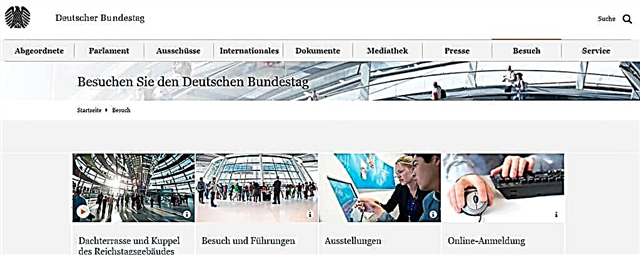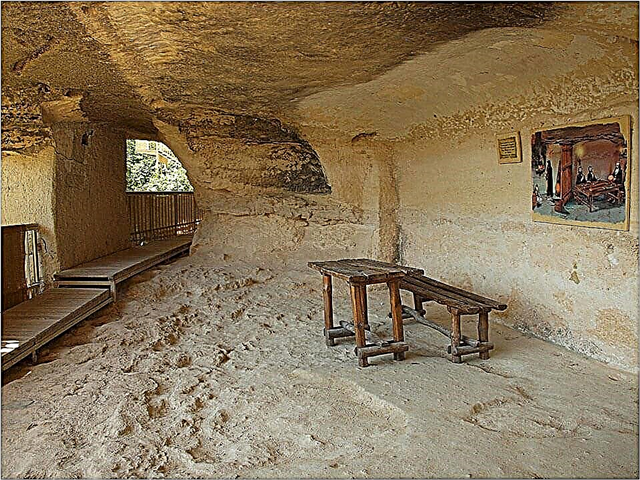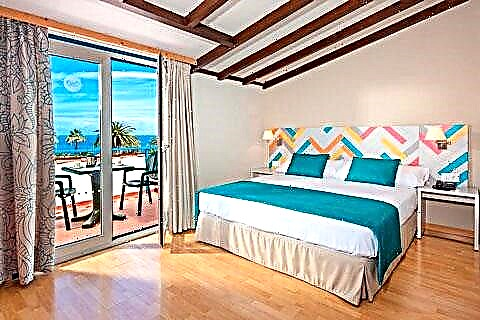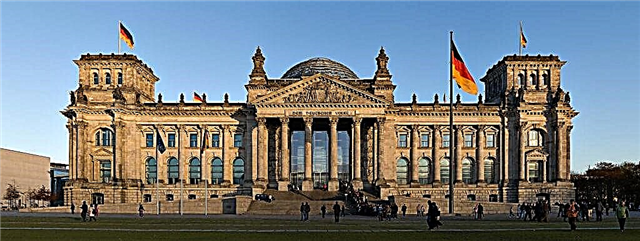"To the German people". These words adorn the facade of a monumental building located in the center of the German capital. The Reichstag in Berlin is not just a place where the FRG's policy is carried out. The building on the banks of the Spree River is a mirror of the country's history, a museum and a magnet that attracts millions of tourists. In 1999, the building (Reichstagsgebaeude) received the status of the most visited parliament in the world.
Value

The word "Reichstag" is translated from German as "the building of the state assembly." Its history began with the creation in 1871 of the German Empire and a parliament of 382 members. Initially, the place of their meetings was the Royal Porcelain Manufactory, but already at that time the question arose about the construction of a new building, later called the Reichstag. Parliament sat there until 1933.
For over 120 years, the Reichstag has been a reflection of German history. Many fateful decisions were made here, such as the country's participation in the First World War. In October 1918, politician Philip Scheidemann announced from one of the balconies the overthrow of the emperor and the creation of a republic. A day after the German reunification, on October 4, 1990, the first symbolic meeting of the representatives of the government of the new Germany was held in the Reichstag.

The resolution, adopted on June 20, 1991, provided for the transfer of parliament from Bonn to Berlin. Today, the restored building hosts meetings of the Federal Assembly twice a month, which after 1949 was named the Bundestag. Its functions are to elect the chancellor, control the activities of the government, and prepare and pass laws.
Construction history

The history of the Reichstag began on June 9, 1884. The first stone was laid by Kaiser Wilhelm I, who rightly believed that a large structure was required for the deputies of the united German Empire. The project was coordinated for 10 years. One of the reasons for such a long period was the refusal of the diplomat Radzinsky to erect a huge building on the land he owned.
Construction was completed only in 1894, during the reign of William II. Parliament has started to work in the new premises. In July 1932, the National Socialist Party won the next elections. Hermann Goering became the chairman of the federal assembly. In January of the following year, Adolf Hitler took over as chancellor, marking the end of the Weimar Republic. Nevertheless, the new government was still very unstable.
Fire of 1933
At Hitler's request, parliament was dissolved, and new elections were postponed to March 5, 1933. Six days before the scheduled day, an event occurred that strengthened the position of the future Fuhrer. On the evening of February 27, the sky above the Spree River was lit up by the reflections of a flame. The dome was burned, but the meeting room suffered the most. The alleged culprit of the fire, a member of the Dutch Communist Party, Van der Lubbe, was discovered on the sidelines.
The Nazis declared the arson as a sign of a "communist uprising". However, modern historians agree that the act was planned by the supporters of the dictator. The provocation brought political luck to the Nazis - a day after the fire, Reichst President Hindenburg signed a decree limiting a number of civil rights and freedoms. The document was drawn up by Hitler's coalition. The Communist Party was officially banned.
Reichstag under Hitler

In August 1934, the founder of the NSDAP appropriated the title of Fuhrer, and a few days later - President of the Third Reich. The Reichstag ceased to be a stronghold of Germany - the imperial chancellery and Hitler's bunker became the concentration of power. The gigantic building was used by the Nazis first as a center of anti-Semitism, and with the advent of World War II - as a base for the air force, headed by Reich Minister Hermann Goering. A hospital was located in several rooms.
Despite this, for the soldiers of the Soviet army, the Reichstag was a Nazi bastion, the destruction of which symbolized the surrender of Nazi Germany. On the first day of May 1945, the red Victory Banner was proudly raised over the roof of the house of German parliamentarism.
Post-war condition and restoration of the building
As a result of the air raids of the Second World War and the subsequent assault, the building was badly damaged. After the division of Germany, it turned out to be on the territory of the FRG, next to it was the Berlin Wall. In the hungry years of the post-war period, the inhabitants of the city grew potatoes on the land around the ruins of a once powerful structure. In 1954, because of the danger of collapse, a dome riddled with shells was blown up, and some of the bas-reliefs were removed from the disfigured facade.
In 1956, representatives of the FRG authorities for the first time started talking about the restoration of the once mighty structure. The work was completed in 1972. The modernized building, which lost its dome, was used for historical exhibitions.
The decision on the final reconstruction was taken in 1991 after the signing of a resolution on the transfer of the Bundestag from Bonn to Berlin. The Englishman Norman Foster was appointed the architect. But even before the restorers got down to work, a spectacular event awaited the historical monument, organized by a married couple of artists Christo and Jean-Claude.
In June 1995, climbers wrapped the building with a special silvery cloth with an area of about 100 thousand m2 and pulled it down with blue ropes. The two-week campaign attracted millions of people, and photographs of the "wrapped up Reichstag" were circulated around the world. The doors of the renovated Bundestag House were opened on April 1, 1999.
Dome and wall of memory

One of the features of the architectural appearance of the modern Reichstag is a unique grandiose dome, inside which there are two spiral staircases 230 m long. Its current appearance was created during the last restoration. The idea belonged to the architect Norman Foster.
The spherical structure is made of steel and solid sheets of superhard glass. Its height is 23.5 m, cross section - 38 m, weight - 1.2 thousand tons. The complex system is not only a roof, but also a light and temperature regulator of the premises inside the building. The upper level of the glass dome is an observation deck.
In the middle, there is an unusual cone-shaped device of 360-degree rotating and computer-controlled mirrors extending to the foundation. They form a funnel and perform two functions: ventilation of the plenary hall and supplying it with reflected daylight.

The second visiting card of the building is the wall of memory left to the descendants of the soldiers of the Soviet Army who stormed Berlin. Many recordings, mostly obscene, were destroyed during the first reconstruction - in the 60s of the last century.
At the beginning of the XXI century, the question of erasing the inscriptions arose, and the deputies of the Bundestag brought it up for consideration. As a result, the overwhelming majority of voters spoke out against the elimination of signs reminiscent of the crimes of Nazism against humanity. It was decided to leave the wall. For safety, its surface was treated with a transparent glassy compound.
Features of the architecture

The architect of the Reichstag is Paul Wallot, one of 190 applicants who took part in the competition for the construction of the parliamentary building. Merits in the design of a building of national importance became the reason for assigning him the position of a privy councilor for construction.
According to Vallot's idea, the country's main structure, with its massive appearance, should give the impression of absolute imperial power. Its height is 47 m, length - 137 m. The building has the shape of a square, in the corners of which there are towers decorated with allegorical sculptures. They personify the states that united in 1871 into a single Empire: Bavaria, Saxony, Württemberg and Prussia.
The architecture of the building includes elements of the Renaissance, Baroque and Classicism.The main facade is decorated in the style of an ancient Roman portal. The central entrance is decorated with six pairs of columns. In the upper part there is a portico decorated with a triumphal bas-relief depicting a scene symbolizing the unification of the kingdoms of the German Empire. The overall external massiveness is softened by steel structures, glazed rooms and decorative concrete. The building is crowned with a legendary dome.
In 1916, letters were placed on the pediment, cast from parts of Napoleon's cannons and making up the inscription "The German people" (Dem deutschen Volke).
The Reichstag has retained its old façade, but inside it has acquired a modern look. The building consists of several levels, the first of which includes a 1,200 m2 plenary hall and offices for deputies and employees. Above is the territory for visitors, and above it is the level of the Federal President of the Federal Republic of Germany.
Opening hours and order of visit

You can visit the Reichstag free of charge as part of an excursion group. Opening hours: daily from 8:00 to 24:00, last entry at 21:45. Access closed:
- all day 24.12 and 31.12 from 16:00
- during maintenance from 12 to 16 March, from 9 to 13 July, from 23 to 27 July and from 8 to 12 October
The entrance is located to the right of the famous landmark. For fire safety reasons, only 600 people can visit the dome at the same time, and on the days of plenary and factional meetings - no more than 200. The time spent in the internal premises is 90 minutes.
You can use the free audio guide in Russian. Every 20 minutes, the device will inform about the surroundings of the Reichstag, the peculiarities of the work of the German Bundestag and the nearby attractions of Berlin. Models are available for children and hearing impaired people.
Access to the building is possible only after preliminary registration (at least two days before the intended visit) and obtaining permission. Attention! Registration is not required for those wishing to dine in the terrace restaurant. You can reserve a table by phone + 49 030 22 62 99 33 or by mail [email protected]. Opening hours: from 9:00 to 16:30 and from 18:30 to 24:00.
For those who decide to pay a visit spontaneously: subject to the presence of the original passport, you can register at the service pavilion located next to the Reichstag on the south side of Sheidemannstrasse. Access permits are issued here from two hours to two days prior to the visit. This service is available from 8:00 to 18:00 (November to March) and from 8:00 to 20:00 (April to October). Waiting time in line varies from 30 minutes to 2 hours.
Registration and contact information

In November 2010, the threat of a terrorist attack from one of the Islamist groups caused the dome and the restaurant on the terrace to be closed. For tourists, the Reichstag was reopened only in the second half of 2011. The condition of the visit was the obligatory registration of guests on the official website www.bundestag.de/besucher. Visitors can choose a language (German, English, French, Arabic), a convenient date and time of the visit, indicating two alternative days and hours.
Booking instructions:
- Go to the above site and specify your language (German by default). Select the Online-Anmeldung heading, then one of the four suggested excursions:
- visit to the plenary hall and climb to the dome;
- lectures on historical and political topics in the parliamentary hall and ascent to the dome;
- the guide's story about the Reichstag and the ascent to the dome;
- visiting the dome without a guide.
- Specify the number of people in the group and click the weiter button (next).
- The next page tells about the visiting rules. Your task is to enter the captcha and click "next".
- Select the date, time and desired alternative (if available). Further.
- Enter the details of the visitor or group leader (name, surname, status (Privatperson), address: street, house number, zip code, city), phone number and e-mail address. Further.
- Carefully check the entered information, put a cross in the Datenshutzhinweis section (agreement with the rules). Click on the "Anfrage absenden" button.
- A letter comes to the mail with a link, which you need to follow and re-enter your personal data. The confirmation of the visit is a final letter. It must be printed out and presented along with the passport at the entrance to the Reichstag.
Important! When planning your visit to the Houses of Parliament, leave your backpacks and large bags at the hotel or in the luggage room of a nearby station.
Where is it located and how to get there

The plenary building is located in the center of Berlin on Republic Square (Platz der Republik). A stone's throw from it flows the river Spree, clad in granite. To visit a key German landmark, you can use public or private transport:
- By metro: line U55 to the Bundestag stop. Line U2 - to Potsdamer Platz. Then walk along the Ebertstasse street or through the park (Tiergarten) to the Strasse des 17. Juni street, on the other side of which the Reichstag is located. Travel time is 15–20 minutes.
- By train (S-Bahn): Lines S3, 5, 7, 9 to Central Station (Hauptbahnhof) or S1, 2, 25 and 26 to Brandenburger Tor.
- By bus: Line 100 - to the Reichstag / Bundestag stop, TXL - to Brandenberger Tor; Nos. 142, 147, 245 and M5, 8, 10, 41, 85 to Hauptbahnhof, then cross the Spree over the Moltkebruecke.
- By car: to Sheidemannstrasse or Paul Loebe Allee. The number of parking spaces is limited.
Address: Platz der Republik 1, 11011 Berlin. GPS coordinates: 52 ° 31 ′ 7.032 ″ N 13 ° 22 ′ 34.273 ″ E.











